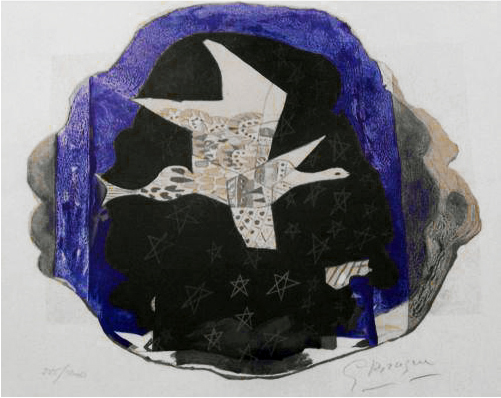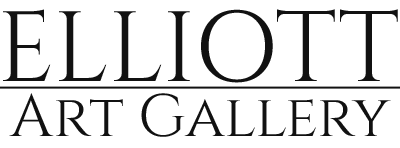Georges Braque (1882 – 1963) belongs to the small cadre of 20th-century artists who reshaped not just painting but the very idea of what a picture could be. Co-inventor of Cubism, refined colorist, and innovative printmaker, Braque moved restlessly from Impressionist roots through Fauvism and Analytical Cubism to late lyrical compositions of birds and studios.
Collectors value his work for its formal rigor, tactile surface, and understated poetry. At Elliott Gallery, our curated selection of Georges Braque prints for sale offers New Orleans audiences and global connoisseurs the rare chance to live with an original by this modern master.

Early Life and Training
Born in the riverside town of Argenteuil and raised in Le Havre, Braque originally planned to join the family house-painting trade. Evening classes at the École des Beaux-Arts, however, ignited a deeper ambition.
By 1902 he had relocated to Paris and enrolled at the progressive Académie Humbert, where he absorbed Impressionist color theory and the structural lessons of Paul Cézanne. These formative years instilled both technical discipline—he could still line-stripe a paneled door with a decorator’s precision—and a lifelong curiosity about surface texture and craft.
The Fauvist Interlude (1905-1907)
Braque’s first stylistic leap came after seeing the blazing canvases of Henri Matisse and André Derain at the 1905 Salon d’Automne. Abandoning muted Impressionist tones, he painted the ports of L’Estaque and Antwerp in unmixed emeralds, pinks, and oranges. Works such as Houses at L’Estaque compress architecture into flat color slabs, signaling his shift from recording retinal sensation to constructing pictorial space.
Braque’s Fauvist palette, 1906”
Even in this fiery phase Braque retained a draftsman’s eye for structure. Where Matisse dissolved form in color, Braque began rotating it, testing how planes could interlock like facets of a crystal—a prelude to Cubism.
Braque Meets Picasso: Birth of Cubism
The hinge moment in modern art arrived in late 1907, when Braque visited Pablo Picasso’s studio and saw Les Demoiselles d’Avignon. The two artists recognized a shared desire to upend Renaissance perspective. Working side by side in the mountain village of Horta and later in Montmartre, they developed Analytical Cubism (1908-1911), dissecting objects into shifting angles rendered in ochres and charcoals. Critics joked the pictures looked like “little cubes,” inadvertently naming the movement.
Braque’s Violin and Palette (1909) illustrates the method: a suspended palette, painted trompe-l’œil nails, and fractured violin merge foreground and background. By suppressing color, he emphasized form, line, and edge—foundations of abstraction. The partnership was remarkably egalitarian; many canvases are nearly indistinguishable, yet Braque’s quiet temperament often ceded the spotlight to Picasso’s flamboyance.
Papier Collé & Synthetic Cubism (1912-1914)
In 1912 Braque introduced papier collé, pasting faux-wood wallpaper onto drawings such as Fruit Dish and Glass. This radical gesture declared that real-world materials—newsprint, musical-score fragments, sanded paper—could coexist with painted illusion. The result was Synthetic Cubism, warmer in color and more playful in composition. Collage would later fuel movements from Dada to Pop, making Braque an unheralded father of mixed-media art.
Signature Artistic Techniques
Braque’s oeuvre is distinguished by meticulous craft married to conceptual daring. Before exploring his market, it helps to understand the studio practices that give his work its quiet power.
- Textured Pigments and Additives
Braque frequently mixed sand, sawdust, or iron filings into oil paint, then scraped or combed the surface. Under gallery lighting, these micro-topographies catch the eye, distinguishing a genuine Braque from later imitations. - Muted, Architectural Palette
After 1907 he rarely used pure bright hues, preferring umbers, slates, dusty greens, and velvety blacks. Collectors find these tones easy to integrate into both traditional and contemporary interiors. - Musical Motifs
An amateur flutist, Braque compared painting to musical rhythm. Guitars, violins, and sheet music recur across decades, allowing scholars to trace stylistic evolution within a constant theme. - Bird Lithographs
In the 1950s poor health limited large canvases, yet Braque produced luminous lithographs of birds in flight. Their weightless whites and floating blacks appear to hover above colored grounds, epitomizing the spiritual serenity of his late work.
Career Milestones Beyond Cubism
World War I interrupted Braque’s ascent. Serving on the front, he suffered a severe head wound in 1915 and spent two years recovering. The experience deepened his sensitivity to intimate, domestic subjects.
- 1917-1923 – Return & Recognition
Braque re-entered Parisian life with still lifes that balanced Cubist structure and richer color. A 1922 retrospective at the Salon d’Automne confirmed his stature among the école de Paris.
- 1924-1929 – Stage Design for Ballets Russes
Sergei Diaghilev commissioned Braque to design sets and costumes for Les Fâcheux and Zéphyr et Flore. Translating Cubist space into three-dimensional theater expanded his understanding of volume and movement.
- 1930s – Engraved Plasters & International Prizes
Experimenting with sgraffito-like plaster engraving, Braque won first prize at the 1937 Carnegie International in Pittsburgh, broadening his American collector base.
- 1940s – Wartime Themes
Nazi occupation drove him to subdued palettes and somber themes, yet he continued printing clandestine wood engravings—testaments to artistic resilience.
- 1950s-1963 – Late Serenity
The Ateliers series balances studio objects with window views, while the Oiseaux lithographs distill form to pure gesture. In 1961 he became the first living artist honored with a solo exhibition at the Louvre.
Georges Braque at Elliott Gallery
Elliott Gallery has championed modern French printmaking since 1978, steadily building relationships with European ateliers and trusted secondary-market sources. Our current holdings of Braque include etchings, aquatints, and the coveted late lithographs, each backed by full provenance and a certificate of authenticity.
Our curator has grouped the newest arrivals into four easy-to-browse categories. All works include full provenance, a certificate of authenticity, and museum-quality framing options on request.
Signed & Numbered – Braque Lithographs
A trio of late, large-format impressions—each pencil-signed and numbered—showcases the airy, calligraphic touch that defined Braque’s final decade.
- Marine Noir — Original lithograph, 35 11/16 × 25 7/16 in., 1962, edition 35/75
- La Barque Sur la Grève — Original lithograph, 16 × 34 ½ in., 1960, edition 50/75
- Les Étoiles — Original lithograph, 18 ⅞ × 25 ½ in. (unframed), 1960, gallery ref. BRQ-M1029S
Braque Etchings: Théogonie Suite (1953)
Printed at Atelier Lacourière on Arches wove; these three richly inked etchings belong to Braque’s celebrated interpretation of Hesiod’s Theogony.
- Plate #15 — 17 ½ × 13 in., edition 150
- Plate #76 — 17 ½ × 13 in., edition 150
- Plate #5 — 17 ½ × 13 in., edition 150
Braque Original Lithographs
Ideal for first-time collectors, these classic still-life sheets retain the tactile Cubist geometry that made Braque a household name.
- Nature Morte — Original lithograph, 19 × 26 in., edition 300
- Jacket Cover, Derrière Le Miroir 115 — Original lithograph for DLM 115, 11 × 15 in., 1959
Braque – Art in Posters Series
Vibrant exhibition posters published between 1946 and 1959 demonstrate how galleries worldwide presented Braque’s evolving vision. Each poster is an original vintage printing, not a later reproduction.
Inventory changes frequently; please inquire for the most up-to-date availability or to arrange a private viewing.
Braque and the Spirit of New Orleans
New Orleans is a city of syncopated rhythms, layered histories, and Franco-Caribbean hybridity. Braque’s art, with its jazz-like improvisations on guitars and its architectural color chords, resonates naturally here. His muted greens echo live-oak canopies; his fragmented café tables recall the city’s wrought-iron balconies viewed through shutters.
By placing a Braque on your wall, you participate in an ongoing dialogue between French modernism and Crescent City creativity—a perfect conversation piece for collectors who cherish the local cultural mosaic.
Why Collect Georges Braque Prints?
Before listing reasons, it helps to frame collecting as both aesthetic pleasure and long-term stewardship. Braque’s prints satisfy on multiple fronts:
- Foundational Modernist Status – Owning a Braque anchors any 20th-century collection with a direct link to Cubism’s birth.
- Approachable Scale & Price – Prints offer entry points well below eight-figure painting markets while maintaining blue-chip pedigree.
- Technical Diversity – From intaglio to lithography, each process reveals a different facet of his thinking, letting collectors build thematic sets.
- Market Resilience – The Artprice Global Index shows Braque print prices rising roughly 6 % annually over the last decade, outperforming many asset classes.
- Design Flexibility – Neutral palettes complement minimalist lofts and historic Creole cottages alike.
- Guaranteed Authenticity – Elliott Gallery vets every impression against catalogue raisonnés such as Vallier and Dora Vallier’s 1982 compendium, providing peace of mind.
Caring for Your Braque Print
Fine works on paper thrive in stable environments. We recommend:
- Conservation Framing – Acid-free mats, UV-filtering glass (or acrylic), and sealed backing boards.
- Moderate Climate – 68-72 °F and 40-55 % relative humidity prevent paper cockling.
- Low Light – Display away from direct sunlight; LED spots at 50-lux levels render color without UV risk.
- Periodic Check-ups – Our specialists offer complimentary annual inspections for local clients.
Frequently Asked Questions
Collectors new to Braque often share similar questions. The answers below draw on decades of secondary-market experience.
Are Braque prints hand-signed?
Many lithographs from 1947-1963 bear graphite signatures; earlier etchings sometimes carry plate signatures alone. Each Elliott Gallery listing specifies signing method, edition size, and condition grade.
Do you ship internationally?
Yes. We coordinate secure FedEx or fine-art-shipper delivery, fully insured. Customs documentation is handled in-house to streamline the process.
How do Braque prices compare to Picasso’s?
While Picasso remains the market’s superstar, Braque offers comparable historical importance at valuations 30-50 % lower, appealing for diversification.
Can I view recent auction comparables?
Upon request we provide Artprice and Artnet sales data, including hammer totals and buyer’s premiums, to help you make informed decisions.
Legacy and Influence
Braque’s quiet rigor influenced artists from Juan Gris to Jasper Johns. His collage experiments foreshadowed Robert Rauschenberg’s combines, while his restrained palette inspired Giorgio Morandi’s contemplative still lifes. Museums worldwide celebrate his contributions: the Centre Pompidou’s 2023-24 retrospective drew record crowds, and MoMA recently re-hung its Cubist galleries to foreground Braque alongside Picasso, underscoring his equal role in the movement’s genesis.
Collectors who secure a Braque today participate in this ongoing scholarly reevaluation, often discovering renewed market attention as exhibitions travel and new monographs appear.
Bringing Braque Home
Whether you respond to the structural daring of Cubism or the meditative grace of his late bird lithographs, a Georges Braque print offers daily encounters with one of modern art’s true architect-poets. Elliott Gallery—nestled in the heart of New Orleans’ French Quarter—invites you to explore our current holdings online or schedule a private in-gallery viewing. Let us guide you through provenance, framing, and long-term care so your Braque can soar for generations.
